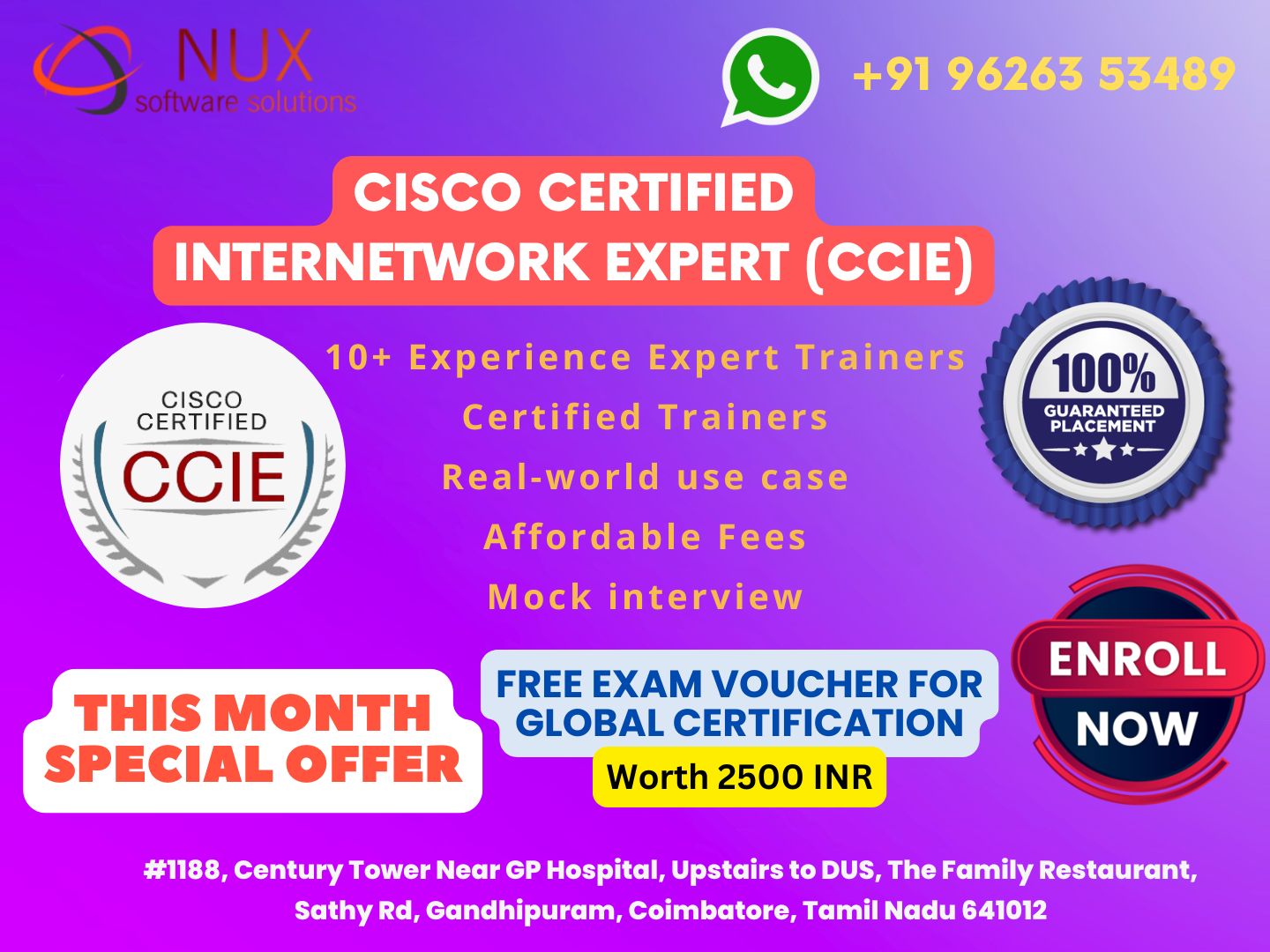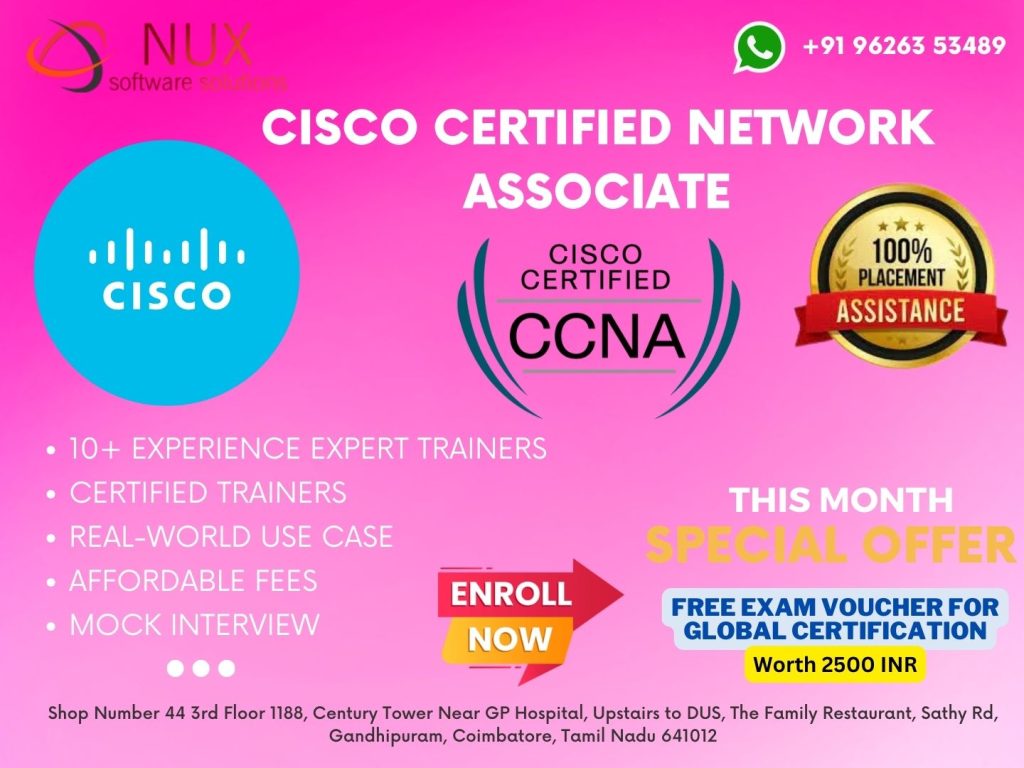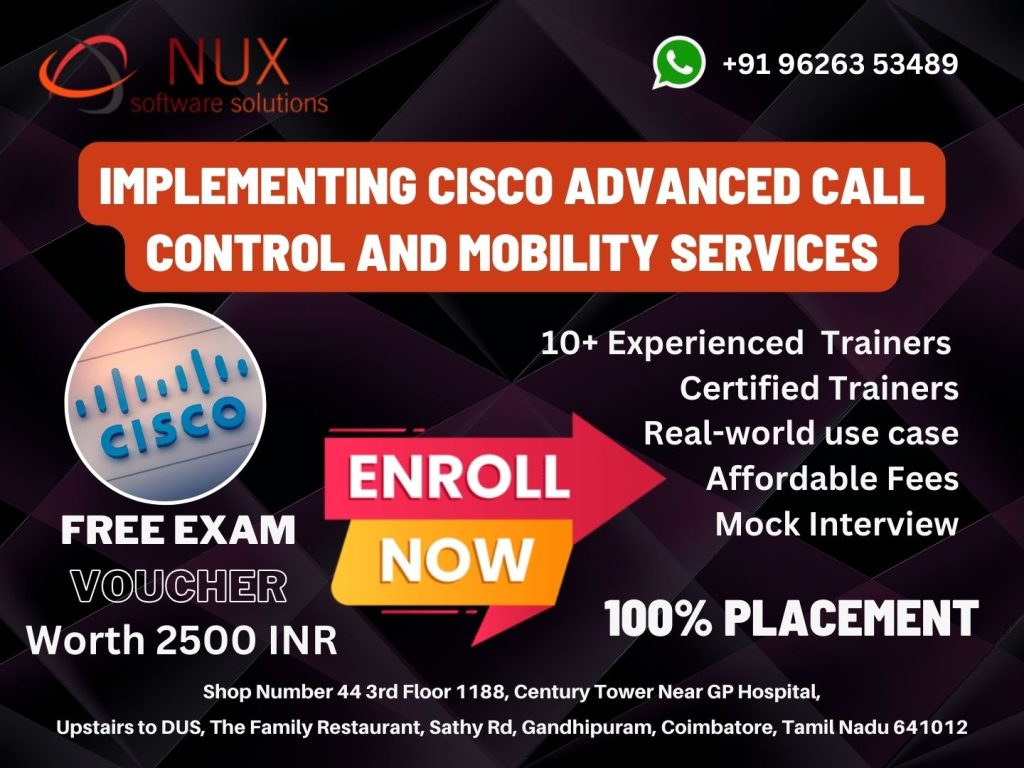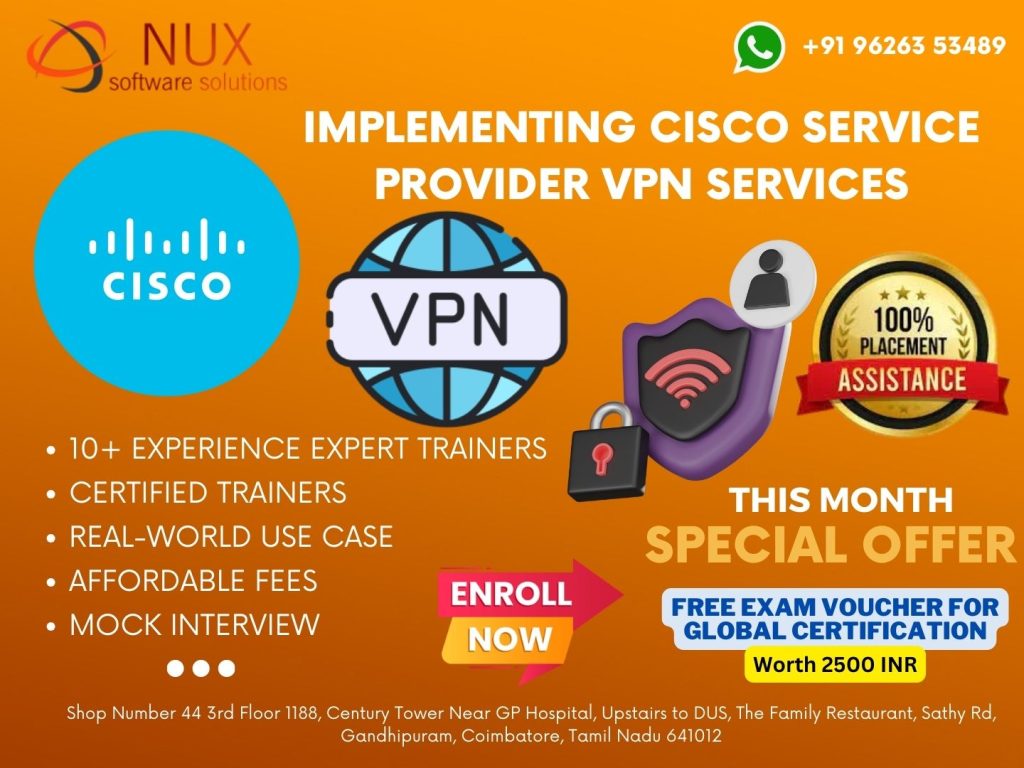Cisco Certified Internetwork Expert (CCIE)

Cisco Certified Internetwork Expert (CCIE) Training in Coimbatore
Course Overview
The Cisco Certified Internetwork Expert (CCIE) is Cisco’s most prestigious and advanced certification, globally recognized as a benchmark of networking excellence. It validates expert-level knowledge and skills in planning, operating, and troubleshooting complex network infrastructures. The CCIE certification is available in multiple tracks including Enterprise Infrastructure, Enterprise Wireless, Data Center, Security, Collaboration, and Service Provider.
At Linux Training Center in Coimbatore, our CCIE training program is crafted for experienced networking professionals who are ready to push their skills to the highest level. The course blends deep theoretical knowledge with rigorous hands-on lab practice, simulating real-world enterprise environments.
Whether you’re pursuing CCIE Enterprise Infrastructure, CCIE Security, or any other specialization, we provide personalized training paths aligned with the current Cisco blueprint and lab exam formats.
Why Choose CCIE Certification?
The CCIE credential opens doors to top-tier network engineering roles, high-paying global opportunities, and unparalleled credibility in the industry. Cisco CCIE-certified professionals are often sought after for network architecture, consulting, and high-level troubleshooting roles in MNCs and global enterprises.
The CCIE journey is demanding but immensely rewarding — it demonstrates not only technical mastery but also commitment and strategic thinking in handling complex network challenges.
Who Should Enroll?
This course is ideal for:
-
Network engineers with 4+ years of enterprise experience
-
Cisco CCNP-certified professionals looking to move to the expert level
-
Senior infrastructure professionals preparing for complex network environments
-
IT consultants and architects working in large-scale networking projects
-
Individuals aiming for leadership roles in network design and operations
A solid understanding of Cisco networking technologies and practical experience is strongly recommended.
Available CCIE Tracks
We offer expert training for the following CCIE specializations:
-
CCIE Enterprise Infrastructure
-
CCIE Enterprise Wireless
-
CCIE Security
-
CCIE Data Center
-
CCIE Service Provider
-
CCIE Collaboration
Each track includes both a qualifying exam (core technology) and an 8-hour hands-on lab exam.
What You Will Learn
While specific topics vary by track, a typical CCIE training covers:
-
Advanced routing protocols (OSPF, EIGRP, BGP, MPLS)
-
Layer 2 and Layer 3 technologies
-
Network automation and programmability
-
Network infrastructure security and segmentation
-
Troubleshooting high-availability enterprise systems
-
Software-defined networking (SDN) and SD-WAN
-
Deep configuration, monitoring, and optimization
-
Designing scalable, redundant, and secure topologies
-
Expert-level lab scenarios using Cisco platforms
Our labs simulate the official Cisco CCIE Lab environment, giving candidates the confidence to take on the real exam.
Course Highlights
-
100% hands-on CCIE lab simulation experience
-
Mentoring by CCIE-certified instructors
-
Individualized support and progress tracking
-
Lab-focused modules aligned with Cisco’s latest blueprints
-
Exclusive practice workbooks, mock labs, and troubleshooting drills
-
Flexibility to choose specialization and training mode (classroom or online)
-
Ideal for professionals targeting global job markets or top-level roles
Career Opportunities
CCIE-certified professionals are highly valued and often take on strategic roles such as:
-
Senior Network Engineer / Architect
-
Network Design Consultant
-
Infrastructure Lead / IT Architect
-
Principal Engineer
-
Global Network Operations Specialist
-
Cloud and Security Solution Architect
CCIE holders often command premium salaries and leadership roles in Fortune 500 companies, telecom giants, and global consultancies.
Why Train at Linux Training Center, Coimbatore?
Linux Training Center is known for delivering expert-level training with practical depth and real-time lab support. Our CCIE training is structured for serious professionals who aim to excel. With access to world-class lab infrastructure, constant mentoring, and outcome-driven learning, we help you make the leap to Cisco’s elite certification level.
Cisco Certified Internetwork Expert (CCIE) Syllabus
Module 1
Chapter 1
Describe WLAN organizations and regulations
Chapter 2
Describe IEEE 802.11 standards and protocols
Chapter 3
Plan & design wireless solutions requirements, a) Translate customer requirements into services and design recommendations, b) Identify ambiguity and/or information gaps, c) Evaluate interoperability of proposed technologies against deployed IP network infrastructure & technologies, d) Select an appropriate deployment model, e) Regulatory domains and country codes
Chapter 4
RF planning, designing and validation
a) RF Design / Site survey
[i] Define the tasks/goals for a preliminary site survey, [ii] Conduct the site survey, [iii] Determine AP quantity, placement and antenna type
b) Architect indoor and outdoor RF deployments
[i] Coverage, [ii] Throughput, [iii]Voice, [iv]Location, [v] High Density / Very High Density
c) Construct an RF operational model that includes:
[i] Radio resource management (Auto-RF, manual, hybrid, Flexible Radio Assignment, TPC and DCA), [ii] Channel use (radar, non-WiFi interference, Dynamic Bandwidth Selection), [iii] Power level, overlap, [iv] RF profiles
d) Validate implemented RF deployment
MODULE 2 : Configure and Troubleshoot the Network Infrastructure
Chapter 1
Configure and troubleshoot wired infrastructure to support WLANs, a) VLANs, b) VTP, c) STP, d) Etherchannel
Chapter 2
Plan network infrastructure capacity
Chapter 3
Configure and troubleshoot network connectivity for:, a) WLAN clients, b) WLCs (appliance, virtual, and Mobility Express), c) Lightweight APs, d) Autonomous APs
Chapter 4
Configure and troubleshoot PoE for APs
Chapter 5
Configure and troubleshoot QoS on the switching infrastructure
a) MQC, b) MLS QoS
Chapter 6
Configure and troubleshoot multicast on the switching infrastructure, a) PIM, b) Basic IGMP (including IGMP snooping), c) MLD
Chapter 7
Configure and troubleshoot IPv4 connectivity, a) Subnetting, b) Static and inter-VLAN routing
Chapter 8
Configure and troubleshoot basic IPv6 connectivity, a) Subnetting, b) Static and inter-VLAN routing
Chapter 9
Configure and troubleshoot wired security for APs, a) MAB, b) dot1X for APs
Chapter 10
Configure and troubleshoot the following to support wireless services, a) DNS, b) DHCPv4 / DHCPv6, c) NTP, SNTP, d) SYSLOG, e) SNMP, f) CDP, LLDP, g) mDNS (including SDG)
MODULE 3 : Configure and Troubleshoot an Autonomous Deployment Model
Chapter 1
Configure and troubleshoot different modes and roles, a) WGB, b) Point to point & Point to multi-point bridge
Chapter 2
Configure and troubleshoot SSID/MBSSID
Chapter 3
Configure and troubleshoot security, a) L2 security policies, b) Association filters, c) Local radius, d) dot1X profiles
Chapter 4
Configure and troubleshoot radio settings
Chapter 5
Configure and troubleshoot multicast
Chapter 6
Configure and troubleshoot QoS
MODULE 4 : Configure and Troubleshoot AireOS appliance, virtual, and Mobility Express controllers
Chapter 1
Configure and troubleshoot secure management access and control plane, a) AAA, b) CPU ACLs, c) Management via wireless interface, d) Management via dynamic interface
Chapter 2
Configure and troubleshoot interfaces
Chapter 3
Configure and troubleshoot lightweight APs, a) dot1x, b) AP modes, c) AP authentication / AP authorization, d) Logging, e) Local AP CLI configuration, f) WLC based AP configuration
Chapter 4
Configure and troubleshoot high availability and redundancy, a) SSO, b)N+1, N+N
Chapter 5
Configure and troubleshoot wireless segmentation, a) RF profiles, b) AP groups, c) FlexConnect
Chapter 6
Configure and troubleshoot wireless security policies, a) WLANs, b) L2/L3 security, c) Rogue policies, d) Local EAP, e) Local profiling, f) ACLs, g) Certificates
Chapter 7
Configure and troubleshoot FlexConnect and Office Extend
Chapter 8
Configure and troubleshoot Mesh
Chapter 9
Implement RF management, a) Static RF management, b) Automatic RF management, c) CleanAir, d) Data rates, e) RX-SOP, f) Air Time Fairness (ATF), g) Flexible Radio Assignment (FRA)
Chapter 10
Configure and troubleshoot mobility, a) L2/L3 roaming, b) Multicast optimization, c) Mobility group scaling, d) Inter-release controller mobility, e) Mobility anchoring
Chapter 11
Configure and troubleshoot multicast
Chapter 12
Configure and troubleshoot client roaming optimization, a) CCKM, b) Optimized Roaming, c) Band Select, d) Load Balancing, e) 802.11r/k/v
MODULE 5 : Configure and Troubleshoot Wireless Security & Identity Management with ISE
Chapter 1
a) Basic PKI for dot1x and WebAuth, b) External identity sources (AD)
Chapter 2
Configure and troubleshoot AAA policies, a) Client authentication and authorization, b) Management authentication and authorization, c) Client profiling and provisioning,
d) RADIUS attributes, e) CoA
Chapter 3
Configure and troubleshoot wireless guest management, a) Local web authentication, b) Central web authentication, c) Basic sponsor policy
MODULE 6 : Configure and Troubleshoot Prime Infrastructure and MSE/CMX
Chapter 1
Configure and troubleshoot management access, a) AAA, b) Virtual domain
Chapter 2 Perform basic operations, a) Create and deploy templates, b) Operate maps, c) Import infrastructure devices, d) High availability, e) Audits
f) Client troubleshooting, g) Notification receivers, h) Reports, i) Monitoring policies
Chapter 3
Configure and troubleshoot Prime Infrastructure jobs
Chapter 4
Operate Security management, a) Configure rogue management, b) Manage alarms and events
Chapter 5
Implement and troubleshoot MSE/CMX,
a) Management access,
b) Network services
[i] Location, [ii] Analytics, [iii] Connect and Engage, [iv] CleanAir, [v] wIPS
c) NMSP
Chapter 6
Integrate ISE with Prime Infrastructure and MSE/CMX
MODULE 7 : Configure and Troubleshoot WLAN media and application services
Chapter 1
Configure and troubleshoot voice over wireless, a) QoS profiles, b) EDCA, c) WMM, d) BDRL, e) Admission control, f) MQC/MLS
Chapter 2
Configure and troubleshoot video and media, a) Media Stream, b) Admission control
Chapter 3
Configure and troubleshoot mDNS, a) mDNS proxy, b) Service discovery, c) Service filtering
Chapter 4
Configure and troubleshoot AVC and netflow
Chapter 5
Configure and troubleshoot FastLane and Adaptive Fast Transition (802.11r)
MODULE 8 : Evolving Technologies v1.1
Chapter 1 Cloud
a) Compare and contrast public, private, hybrid, and multicloud design considerations
[i] Infrastructure, platform, and software as a service (XaaS), [ii] Performance, scalability, and high availability, [iii] Security implications, compliance, and policy, [iv] Workload migration
b) Describe cloud infrastructure and operations
[i] Compute virtualization (containers and virtual machines), [ii] Connectivity (virtual switches, SD-WAN and SD-Access), [iii] Virtualization functions (NFVi, VNF, and L4/L6), [iv] Automation and orchestration tools (CloudCenter, Cisco DNA-center, and Kubernetes)
Chapter 2 Network programmability (SDN)
a) Describe architectural and operational considerations for a programmable network
[i] Data models and structures (YANG, JSON and XML), [i] Device programmability (gRPC, NETCONF and RESTCONF), [ii] Controller based network design (policy driven configuration and northbound/ southbound APIs), [iii] Configuration management tools (agent and agentless) and version control systems (Git and SVN)
Chapter 3 Internet of things (IoT)
a) Describe architectural framework and deployment considerations for IoT, [i] IoT technology stack (IoT Network Hierarchy, data acquisition and flow), [ii] IoT standards and protocols (characteristics within IT and OT environment), [iii] IoT security (network segmentation, device profiling, and secure remote)



